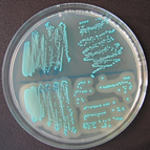You are here:
National Reference Laboratory for Listeria monocytogenes (NRL-Lm)

Listeria monocytogenes triggers an infectious disease in humans and animals which is called listeriosis. This disease does not occur very often but it does have one of the highest morbidity rates (10-30%) amongst foodborne infections. The pathogen is mainly ingested from contaminated food. In humans it triggers non-specific and flue-like symptoms, sometimes linked with diarrhoea. Severe cases mainly occur in individuals with a weakened immune system, older individuals, pregnant woman and their unborn or newborn babies.
The pathogen Listeria (L.) monocytogenes is found in various forms in the environment. Soil and rotten plant material are natural sources. Besides L. monocytogenes, the strain Listeria only encompasses five other species (L. innocua, L. ivanovii, L. seeligeri, L. welshimeri, L. greyi). One special characteristic of Listeria is its ability to multiply even under the most unfavourable conditions, for instance at low temperatures (in the fridge), at a low pH or high salt content. At the present time only L. monocytogenes is deemed to be pathogenic for human beings.
Besides the transmission of L. monocytogenes through direct animal contact, human beings can also become infected from food. Frequently, these are foods which have come into contact with L. monocytogenes during recovery, production, treatment or storage.
The National Reference Laboratory for Listeria monocytogenes is attached to BfR. The focus of its work is on differentiating Listeria isolates. To this end the Reference Laboratory can draw on numerous modern molecular-biological methods which are used in accordance with the provisions of ISO standard 17025 under accredited conditions.
Main areas of the NRL for Listeria monocytogenes
The main areas of work of the National Reference Laboratory for Listeria monocytogenes include:
- Assumption of the tasks of the National Reference Laboratory in accordance with the Zoonoses Directive
- Development and validation of diagnostic methods
- Strain collection, production of reference material, conduct of interlaboratory tests
- Conduct of elucidation and confirmation tests (serology, molecular biology)
- Advice, preparation of expert opinions
- Annual reporting and publication of work findings
Microbiological diagnosis
The tests are based on ISO 11290-1 and ISO 11290-2 Methods and the related tests for carbohydrate utilisation (e.g. of aesculin, xylosis, rhamnosis) as well as tests on mobility, catalase, oxidase, CAMP test (increased haemolysis in the direct vicinity of the pathogen Staphylococcus aureus). Serological tests lead to classification in one of the 13 serotypes (1/2a, 1/2b, 1/2c, 3a, 3b, 3c, 4a, 4ab, 4b, 4c, 4d, 4e, 7) of L. monocytogenes which are based on the presence or absence of various cellular and flagellar antigens.
Molecular-biological diagnosis
Polymer chain reaction (PCR) is used for Listeria species identification, for the detection of virulence factors or for classification in the main Listeria groups which correspond to the serovars.
Pulse field gel electrophoresis (PFGE) is used for the fine typing and elucidation of epidemiological chains of infection. Co-operation with the EU-wide database PulseNetEurope makes possible Europe-wide comparison of the so-called pulsotypes of relevant Listeria isolates from food and foodborne disease outbreaks in man.
